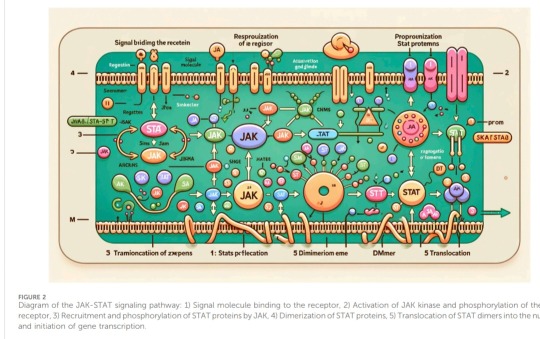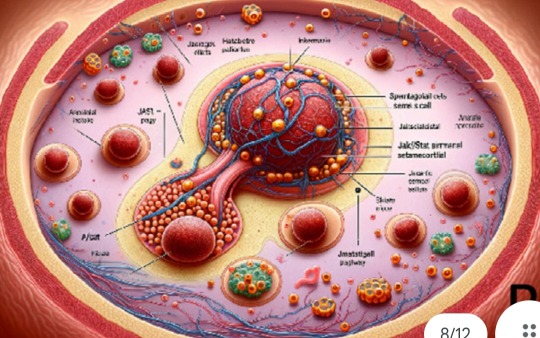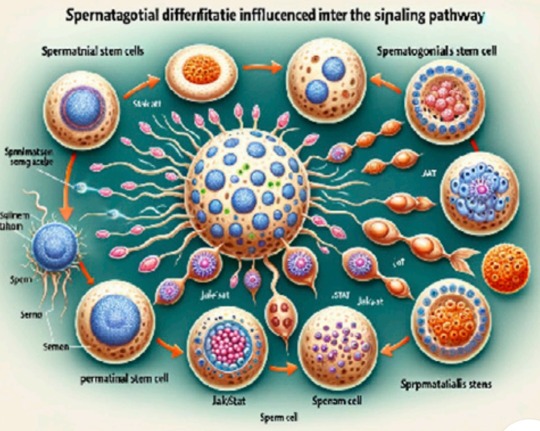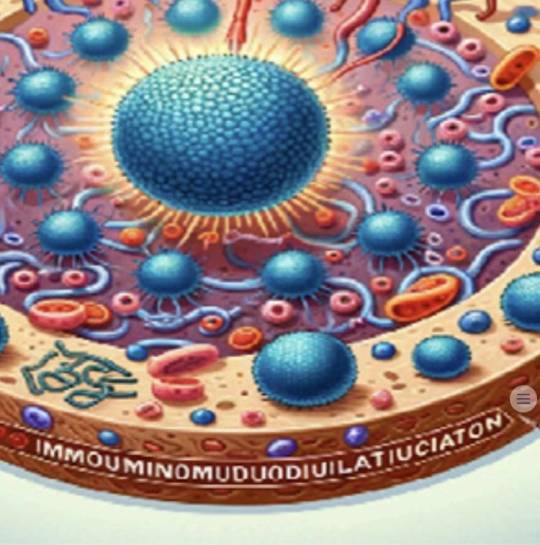#cellular function
Explore tagged Tumblr posts
Text





Is chronic inflammation the missing link between heart disease & osteoporosis? 🧠🦴❤️
Low-grade inflammation silently disrupts cellular function, accelerating bone breakdown and stressing the cardiovascular system. Pro-inflammatory cytokines like IL-6 and TNFα don’t just drive plaque formation—they also stimulate osteoclasts, weakening bone structure.
What if regulating this inflammation isn’t just about medication… but about optimizing the body’s neurological and biochemical control systems?
#inflammation#cellular function#frequency therapy#doctors#healthcare#healthcare professionals#physical therapy#anf therapy#chronic pain#education#medical course#pain therapy
0 notes
Text
Exploring the Benefits of Bestqool's Red Light Therapy Full Body Systems
In the ever-evolving world of medical equipment, Bestqool stands out with its innovative red light therapy full body systems. These devices harness the power of red light to promote healing and overall wellness.
Red light therapy is known for its ability to enhance cellular function, reduce inflammation, and improve skin health. Bestqool's full body systems are designed to provide an immersive experience, allowing users to enjoy the benefits of red light therapy in the comfort of their own homes.
Using these systems can be a game changer for those seeking to improve their physical health and well-being. With consistent use, many users report positive changes such as increased energy levels, improved mood, and enhanced recovery after workouts.
Bestqool is committed to quality and effectiveness, ensuring that each device is crafted with precision and care. If you're looking for a way to support your health journey, consider exploring Bestqool's red light therapy full body options. Embrace the power of light and elevate your wellness today!
#improved mood#energy levels#wellness#health journey#red light therapy#full body systems#quality#cellular function
0 notes
Text
...
#had an interesting conversation with my sister the other day. odd i guess bc my sister is pretty smart#on paper shes smarter than me. or at least less dyslexic than me#but she didnt seem to kno what cancer is. i mean like how it works. i mean. cancer is a mistake. a confluence of unfortunate accidents#leading to unrestrained cellular growth. when it metastasizes. when it moves to other parts of the body. those same cells continue growing#if u have smooth muscle cancer and it moves to your kidney. you body is trying to grow more smooth muscle on your kidney#at least as i understand it. and she asked why it wants to kill you. it doesnt want anything. it just is. its not a thing of malicious#intent. its neutral. it grows. it takes up resources. it takes up space. and it grows and grows until the organ it grows on stops#functioning properly. like a parasite she said. but no. not like a parasite. it grows like an empty space. a mass of flesh. a constant#obstructive pressure. it grows like only a tumor can. i dunno. it didnt seem to connect with her that this thing didnt want to kill our mom#but it did anyway. and she felt weird about how long she lived after they took her off any support. but thats how cancer kills#it stops an organ from functioning and most of those r important so it only takes one. so her heart kept beating for 12 more hrs bc it was#meant to beat for 40 more years. but not much it could do without working kidneys and without working blood#but that's life. that's death. that's nature. its all nutral even if it feels horrible to the individual.#i dunno. i thought it was interesting. shes 25 and her mother had cancer for 10 years so id think shed kno more#we're at a weird phase now bc its been a week since she died and everything feels normal. we'll see what happens at the wake this week#its been interesting for sure bc she was sick for 10 years but my parents didnt prepare at all for her to die#so my dad is scrambling to put together the pieces shr left behind to make sure that all the bills r paid and whatnot. he had to guess her#computer password. she didnt tell us what she wanted us to have. she didnt tell us the importance of her jewelry and who it belonged to#before her. i dunno. we're seeing the outline of my mothers Pathology in what she left behind. both in the physical objects and in the#feelings she imparted. i dunno. its been weird#unrelated
20 notes
·
View notes
Text
Im fucking crying has anyone seen the AI diagrams in the Scientific Study yet?
So, there was a Paper published on the 13th February 2024.
It was published in Frontiers in Cell and developemental Biology, titled
"Cellular functions of spermatogonial stem cells in relation to JAK/STAT signaling pathway""
So far so good, right?
Not knowing anything about the topic, youd exepect a regular Paper: full of scientific theories hopefully to be confirmed and used to widen our human horizons with knowledge.
WRONG. 10 METERS RAT PENIS
Figure 1: Dissilced rat penis.

YES. This was a real picture included in the Paper. I think even without looking at rat dicks regularly (or if ever), you can /kinda/ guess this looks wrong.
If you dont know anything about rat dicks (dont blame you) seeing text like "iollotte sserotgomar cell" or "dck" or "di§locttal stem ells" should make you go hm. Mayhaps this may be wrong.
Another graphic shows the JAK/STAT signaling pathway.

This...is wrong. You cant read the labels. Its wrong and theres non existing symbols and letters and just imagine, imagine youre a newbie Student or scientist or even regular non-academic trying to read this.
Its teaches you nothing and only gives false information.
Of course, this paper passed /2 reviewers/ who said nothing is wrong with it!
This is absolutly unacceptable. Luckily the paper has been retracted now (16.02.2024)

But this is unacceptable. It should never have passed ANY reviewers and saying their job is to rate the scientific merit of the text without looking at the pictures is pure bullshit.
In a scientific papers, graphics and diagrams should have and need scientific merit and integrity, this is the whole point of writing it!
Shame on anyone for letting it get published and i wish the authors would have commissioned someone or even created graphics themselves- no matter how 'crude' or non aesthetic, any graphic drawn in a scientific manner is a thousand times better than AI. Please, stop using AI for important things like that.
I cant say much to the content of the text, but if this was a great paper- now its forever ruined as the Rat dick paper and i wouldnt trust any of the scientists working on it to have honesty and integrity on new papers. I wouldnt publish them.
Lazyness in academia is one thing, but this is just...so bad its sad.
Now, lets look some cells from the paper, shall we?




(I am in distress. This is not a cell.
This is not a cell girl help)
To end this on a better note, shout out to this great tweet lmao!

#tag yourself im an iollotte sserotgomar cell <3#might as well use Ts as error bars. i am crying#academia#papers#frontiers#JAK/STAT#Cellular functions of spermatogonial stem cells in relation to JAK/STAT signaling pathway#jak stat signal pathway#science#scientist#ai#ai art#ai generated#ai image#ai impact#rat penis#rat penis paper
20 notes
·
View notes
Text
one of the downsides to having been diagnosed with my genetic disorder at a young age is that, despite going to the doctor pretty much constantly up until two years ago (which... was inadvisable), i often find new things out about the disorder because i don't actually have much a clue what it does to me because i was a literal child when i found out about it. like i know the big symptoms and satellite issues it causes but some of them i either forgot to time or just never knew. some of the stuff i just kinda assumed was caused by my illness because it made sense with how it operates since im aware of what it does biologically. but i assumed i was tired all the time because i'm in pain all the time, but apparently we literally just have chronic fatigue syndrome in addition. umbilical hernias. bowel tearing (GUESS WHAT HAPPENED TO ME EVERYBODY. WE KNOW WHAT'S WRONG!!). fragile eyes. teeth abnormalities. etc etc etc. im like. OH THAT'S WHY THIS IS HAPPENING? THE THING THAT'S WRONG WITH ME? FOR FUCK'S SAKE.
#it ALWAYS IS WHAT'S WRONG#i dont know why im even surprised at this point like#i know the exact way the disorder functions on a cellular and genetic level so i can just Work Out usually that it's causing a specific#issue#but like COME ON MAN#if you guess the disorder im talking about i'll write something for u and give ur blorbo my disorder. if u want them to suffer<33#i give it to harrow a lot lol i call it the necromancer's disease CAUSE IT IS but that's another post entirely#lessons of the hand and the mouth#ok to rb im sure yall can relate#or someone can
5 notes
·
View notes
Text
Should I Be Using a Sauna After Working Out?
Saunas have long been a staple in gyms and fitness centres worldwide, but should you be using a sauna after working out? This question has sparked debates among fitness enthusiasts and health experts alike. Let’s explore the potential benefits and drawbacks to help you make an informed decision. Statistics: A study published in the Journal of Human Kinetics found that sauna use post-exercise…

View On WordPress
#best practices#blood pressure#cardiovascular health#cellular repair#circulation#cooling down#dehydration#detoxification#Endurance#endurance boost#exercise#Finnish research#Fitness#fitness benefits#fitness routine#gym#health#heart health#heat exposure#heat shock proteins#heat therapy#hydration#hydration tips#intense workouts#medical conditions#mental well-being#muscle function#muscle recovery#muscle soreness#New Zealand study
2 notes
·
View notes
Text
guys i know i’m two million years late but why aren’t we talking more about portrait mode holy shit
#apple has me stuck and literally this phone is functionally an iPod touch because fuck if I know how to actually activate my cellular networ#BUT I FINALLY TRADED MY HOME BUTTON FOR ANOTHER CAMERA THIS THING IS CRAZY#I literally just got a 12 and they’re onto the 15 and I’m over here marveling at the 12 like have y’all seen this tech#everybody else is probably side eying me like yes boom we’ve moved on#BUT LIKE NOW I UNDERSTAND HOW PEOPLE HAVE BEEN DOING THOSE OUTFIT THINGS#PORTRAIT JUST LIKE POPS IT OUT FOR YOU#HERE I WAS WONDERINF WHAT FUCKING EDITTING APP YALL HAD#life of a boomerang
8 notes
·
View notes
Text
Reclaim Vitality: The Science Behind Mitochondrial Biogenesis
Mitochondrial biogenesis is the cellular process of increasing the number of mitochondria, the organelles responsible for generating energy. This process is essential for maintaining cellular health and vitality, particularly in tissues with high energy demands, such as muscles. Mitochondrial biogenesis is often triggered by increased energy demand, usually resulting from exercise, caloric restriction, or the intake of specific nutrients.
Mitochondria are the energy producers of the cell, generating ATP, the energy currency of the cell, through oxidative phosphorylation. As cells face greater energy demands, they need more mitochondria to meet these requirements efficiently. The increase in mitochondrial numbers allows cells to produce more energy and better adapt to stress, thus enhancing overall health, recovery, and performance.
Key Factors Involved in Mitochondrial Biogenesis
Several molecular regulators drive mitochondrial biogenesis, with the most important being:
PGC-1α ActivationPGC-1α (Peroxisome proliferator-activated receptor gamma coactivator 1-alpha) is recognized as the master regulator of mitochondrial biogenesis. This protein plays a pivotal role in controlling the transcription of nuclear genes that encode mitochondrial proteins. When activated by external stimuli like exercise, PGC-1α interacts with transcription factors like NRF-1 and NRF-2 to drive the production of new mitochondria. This results in increased mitochondrial DNA (mtDNA) replication and the synthesis of mitochondrial proteins necessary for energy production and cellular respiration.
AMPK & SirtuinsAMPK (AMP-activated protein kinase) is another critical regulator that responds to low energy levels within the cell (a high AMP ratio). It activates PGC-1α, which, in turn, increases the number of mitochondria. AMPK is activated during energy-demanding activities such as endurance exercise and fasting. Sirtuins (SIRT1) are a class of NAD+-dependent enzymes that also regulate mitochondrial biogenesis. Sirtuins, especially SIRT1, deacetylate PGC-1α, further activating it to promote the transcription of mitochondrial genes. Both AMPK and sirtuins respond to energy deprivation, whether through physical exertion or caloric restriction, helping cells increase energy efficiency and prolong cellular longevity.
Antioxidant Defense and Cellular ResilienceOne of the benefits of mitochondrial biogenesis is the enhancement of cellular resilience through improved antioxidant defences. Mitochondria are not only energy producers but also sources of reactive oxygen species (ROS), which can damage cells if not adequately managed. By increasing the number of healthy mitochondria, cells improve their ability to manage oxidative stress. New mitochondria are typically more efficient at energy production and less likely to produce excess ROS, reducing overall cellular damage. This process helps to protect cells from age-related decline and stress-induced damage.
How Mitochondrial Biogenesis Impacts Health and Performance
Mitochondrial biogenesis is essential for maintaining optimal energy production, particularly during periods of increased physical activity or stress. In muscle cells, the increased number of mitochondria leads to improved ATP generation, enhancing endurance and reducing fatigue during prolonged exercise. This is particularly important for athletes or individuals who engage in regular physical activity, as their muscles require a constant supply of energy for performance and recovery.
For general health, mitochondrial biogenesis supports metabolic efficiency and longevity. In metabolic disorders like type 2 diabetes and obesity, mitochondrial dysfunction often results in impaired energy metabolism and increased oxidative stress. By promoting mitochondrial biogenesis, cells can restore normal mitochondrial function, improving insulin sensitivity and energy balance. Furthermore, mitochondrial biogenesis may help reduce the risk of chronic diseases related to ageing by maintaining cellular energy production and reducing oxidative stress.
Beyond exercise and metabolic health, mitochondrial biogenesis is also a key factor in the body’s ability to adapt to various stressors, whether environmental or nutritional. The increase in mitochondrial capacity allows cells to better handle changes in energy demand, supporting recovery and cellular adaptation. For instance, during periods of caloric restriction, mitochondrial biogenesis helps the body use energy more efficiently, contributing to longer-term health benefits, including improved longevity and resistance to age-related diseases.
Supporting Mitochondrial Biogenesis with Nutraceuticals
In addition to lifestyle factors like exercise and caloric restriction, certain nutraceuticals can support mitochondrial biogenesis. Mitokatlyst™-E is one such product that targets mitochondrial function, optimising energy production, and promoting muscle recovery. By stimulating the molecular pathways involved in mitochondrial biogenesis, such products can enhance the body’s ability to adapt to stress, recover more efficiently, and improve overall cellular function.
Conclusion
Mitochondrial biogenesis is a vital process that supports energy production, cellular health, and adaptability to environmental and physical stressors. By regulating pathways such as PGC-1α, AMPK, and sirtuins, cells can increase mitochondrial content to meet higher energy demands, promote muscle recovery, and improve overall vitality. Products like Mitokatlyst™-E are designed to optimise mitochondrial function, helping the body adapt to stress and maintain optimal cellular health. By supporting mitochondrial biogenesis, we can improve energy efficiency, enhance physical performance, and promote long-term health and resilience.
#Mitochondrial biogenesis#Energy production#Cellular health#ATP generation#PGC-1α activation#AMPK activation#Sirtuins (SIRT1)#Antioxidant defense#Oxidative stress#Mitochondrial function#Muscle recovery#Physical performance#Metabolic efficiency#Insulin sensitivity#Nutraceuticals#Mitokatlyst™-E#Cellular resilience#Longevity#Endurance#Stress adaptation
1 note
·
View note
Text
A new way to see the activity inside a living cell
New Post has been published on https://thedigitalinsider.com/a-new-way-to-see-the-activity-inside-a-living-cell/
A new way to see the activity inside a living cell


Living cells are bombarded with many kinds of incoming molecular signal that influence their behavior. Being able to measure those signals and how cells respond to them through downstream molecular signaling networks could help scientists learn much more about how cells work, including what happens as they age or become diseased.
Right now, this kind of comprehensive study is not possible because current techniques for imaging cells are limited to just a handful of different molecule types within a cell at one time. However, MIT researchers have developed an alternative method that allows them to observe up to seven different molecules at a time, and potentially even more than that.
“There are many examples in biology where an event triggers a long downstream cascade of events, which then causes a specific cellular function,” says Edward Boyden, the Y. Eva Tan Professor in Neurotechnology. “How does that occur? It’s arguably one of the fundamental problems of biology, and so we wondered, could you simply watch it happen?”
The new approach makes use of green or red fluorescent molecules that flicker on and off at different rates. By imaging a cell over several seconds, minutes, or hours, and then extracting each of the fluorescent signals using a computational algorithm, the amount of each target protein can be tracked as it changes over time.
Boyden, who is also a professor of biological engineering and of brain and cognitive sciences at MIT, a Howard Hughes Medical Institute investigator, and a member of MIT’s McGovern Institute for Brain Research and Koch Institute for Integrative Cancer Research, as well as the co-director of the K. Lisa Yang Center for Bionics, is the senior author of the study, which appears today in Cell. MIT postdoc Yong Qian is the lead author of the paper.
Fluorescent signals
Labeling molecules inside cells with fluorescent proteins has allowed researchers to learn a great deal about the functions of many cellular molecules. This type of study is often done with green fluorescent protein (GFP), which was first deployed for imaging in the 1990s. Since then, several fluorescent proteins that glow in other colors have been developed for experimental use.
However, a typical light microscope can only distinguish two or three of these colors, allowing researchers only a tiny glimpse of the overall activity that is happening inside a cell. If they could track a greater number of labeled molecules, researchers could measure a brain cell’s response to different neurotransmitters during learning, for example, or investigate the signals that prompt a cancer cell to metastasize.
“Ideally, you would be able to watch the signals in a cell as they fluctuate in real time, and then you could understand how they relate to each other. That would tell you how the cell computes,” Boyden says. “The problem is that you can’t watch very many things at the same time.”
In 2020, Boyden’s lab developed a way to simultaneously image up to five different molecules within a cell, by targeting glowing reporters to distinct locations inside the cell. This approach, known as “spatial multiplexing,” allows researchers to distinguish signals for different molecules even though they may all be fluorescing the same color.
In the new study, the researchers took a different approach: Instead of distinguishing signals based on their physical location, they created fluorescent signals that vary over time. The technique relies on “switchable fluorophores” — fluorescent proteins that turn on and off at a specific rate. For this study, Boyden and his group members identified four green switchable fluorophores, and then engineered two more, all of which turn on and off at different rates. They also identified two red fluorescent proteins that switch at different rates, and engineered one additional red fluorophore.
Each of these switchable fluorophores can be used to label a different type of molecule within a living cell, such an enzyme, signaling protein, or part of the cell cytoskeleton. After imaging the cell for several minutes, hours, or even days, the researchers use a computational algorithm to pick out the specific signal from each fluorophore, analogous to how the human ear can pick out different frequencies of sound.
“In a symphony orchestra, you have high-pitched instruments, like the flute, and low-pitched instruments, like a tuba. And in the middle are instruments like the trumpet. They all have different sounds, and our ear sorts them out,” Boyden says.
The mathematical technique that the researchers used to analyze the fluorophore signals is known as linear unmixing. This method can extract different fluorophore signals, similar to how the human ear uses a mathematical model known as a Fourier transform to extract different pitches from a piece of music.
Once this analysis is complete, the researchers can see when and where each of the fluorescently labeled molecules were found in the cell during the entire imaging period. The imaging itself can be done with a simple light microscope, with no specialized equipment required.
Biological phenomena
In this study, the researchers demonstrated their approach by labeling six different molecules involved in the cell division cycle, in mammalian cells. This allowed them to identify patterns in how the levels of enzymes called cyclin-dependent kinases change as a cell progresses through the cell cycle.
The researchers also showed that they could label other types of kinases, which are involved in nearly every aspect of cell signaling, as well as cell structures and organelles such as the cytoskeleton and mitochondria. In addition to their experiments using mammalian cells grown in a lab dish, the researchers showed that this technique could work in the brains of zebrafish larvae.
This method could be useful for observing how cells respond to any kind of input, such as nutrients, immune system factors, hormones, or neurotransmitters, according to the researchers. It could also be used to study how cells respond to changes in gene expression or genetic mutations. All of these factors play important roles in biological phenomena such as growth, aging, cancer, neurodegeneration, and memory formation.
“You could consider all of these phenomena to represent a general class of biological problem, where some short-term event — like eating a nutrient, learning something, or getting an infection — generates a long-term change,” Boyden says.
In addition to pursuing those types of studies, Boyden’s lab is also working on expanding the repertoire of switchable fluorophores so that they can study even more signals within a cell. They also hope to adapt the system so that it could be used in mouse models.
The research was funded by an Alana Fellowship, K. Lisa Yang, John Doerr, Jed McCaleb, James Fickel, Ashar Aziz, the K. Lisa Yang and Hock E. Tan Center for Molecular Therapeutics at MIT, the Howard Hughes Medical Institute, and the National Institutes of Health.
#aging#algorithm#Analysis#approach#Behavior#Biological engineering#Biology#Bionics#Brain#Brain and cognitive sciences#brain research#brains#Cancer#cascade#cell#Cells#cellular function#Color#colors#comprehensive#deal#ear#engineering#engineers#enzyme#enzymes#equipment#Events#experimental#Fundamental
0 notes
Text
ok
9 notes
·
View notes
Text
Giving myself crapal tunnel syndrom and a stomach ulcer in the name of academia
#uni adventures#going insane if anyone is intrested#working 2 morning shifts this weekend still have to finish my microbiology notes#and for some reason i still won't put my cellular and molecular biology final on the latter date#<because i won't study for it then this way i might#i might also just lose the function in my hands but whatever#why did i stop writing notes when i had time god only knows now we are cramming it in!!!#the good old ways#i need to remember how i studied anatomy when my hand was half functional so i work some other way#notes are the go to but eughgh hard
2 notes
·
View notes
Note
There two thing about water :
It will make you drown if you chug it down
But you need water to get hydrated lmao
Water is necessary but it's also dangerous
Rushing river and ocean currents can sweep you away and you can drown. But on the other hand, you need water so your cells can make the proteins/sugars you need to stay alive. Water has hydrogen, and hydrogen is essential for some proteins. Not to mention water keeps your blood thin and not thick (I think) :>
But also. Very dangerous. The bottom of the oceans water pressure is equal to thousands of African elephants sitting on your chest.
#it's interesting now that I think about it#that we need to dangerously necessary liquid compound to carry out our basic cellular functions.#bear answers
5 notes
·
View notes
Text
I should eat something that will probably help with making the studying more bearable
2 notes
·
View notes
Text
I haven't read/wtached the manga/anime in full, mostly watching MedTube comment on Cells at Work (and the darker spin-off, Code Black.)
But I'm just looking at the Memory [B] Cell and going, "dat's Virgil."
:,D
#tho more salient /functional/ connection may be some kinda adrenal cell#or some component of the hippocampus-pituitary-adrenal axis / hormone cascade#sanders sides#virgil sanders#medical geekery#(but alas if we made all the side neural cells - that wouldn't be fun in the CAW universe)#(where y'got diversity in cellular functions on display)#(but given the psychological fxns all the sides rep - they'd all likely be neurons)#(and even then - cog fxns aren't stored in singular cells but /nebulous/ clusters/networks of many of them)
0 notes
Text
unfortunately, my blog exists for status quo enjoyment, and so i will not be backing it up. if/when tumblr suddenly decides to succumb to the looming black hole, and one day i wake up to the icon wiped clean from my homescreen neuralyzer style, then that's that and at least the memories (good, bad and ugly) stay with me in my heart.
#also considering my cellular device nor my low-functioning chromebook have enough space for the more than thousands of posts i have#i'm just at peace w the idea that if it goes it goes. and i've had my fill on the countless blogs i've made over the past 5 years#aka im retiring and unless you have my discord im out of office on a beach and will not be answering to emails (forever)
0 notes
Text
From Systems to Cells: A Regenerative Model of Healing and Health | ChatGPT4o
[Download Full Document (PDF)] This document presents a comprehensive exploration of a regenerative model of healing and health, emphasizing the interconnectedness of biological, psychological, social, and ecological systems. The introduction highlights the crisis of coherence within living systems, proposing that health is defined not just by the absence of disease but by the presence of…
#bioenergetics#bioregional governance#Biosemiotics#capillary flow#cellular signaling#ChatGPT#Coherence#coherence cascade#cultural coherence#endothelial function#EZ Water#feedback loops#holistic governance#holistic medicine#integrative health#life-value axiology#Life-Value Ethics#metabolic flexibility#microcirculation#Mitochondria#mitochondrial biogenesis#narrative medicine#neuroendocrine rhythm#oxidative stress#Planetary Health#Polyvagal Theory#pulse-based civilization#redox balance#regeneration#regenerative economy
0 notes